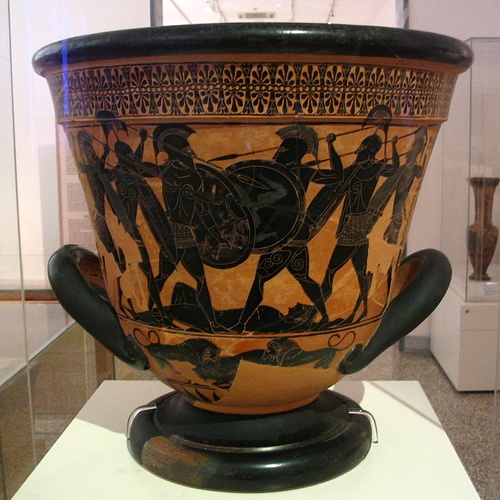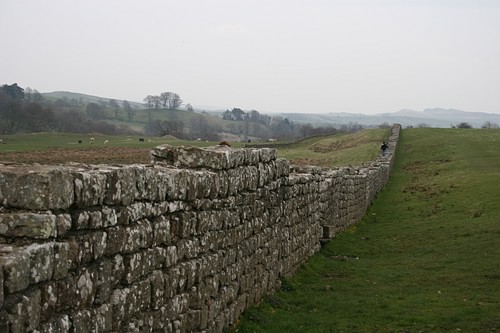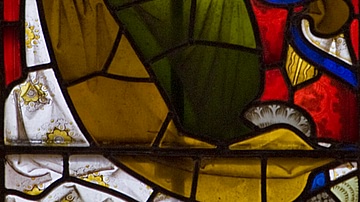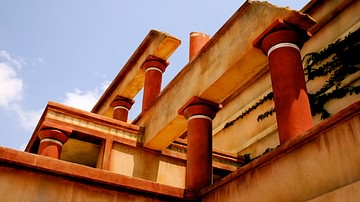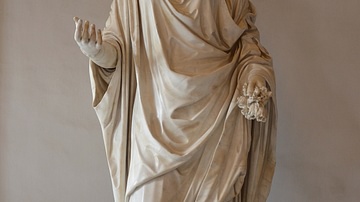Join World History Encyclopedia as they chat with Flora of Flaroh Illustration, a freelance illustrator who loves to create art inspired by archaeological artefacts and myths.
Kelly (WHE): What is your process in creating art based on history?
Flora (Flaroh Illustration): There is not really one set way. Some pieces I choose because I obviously love history and I want to draw that, but other pieces I do are almost the complete opposite. Sometimes I really want to do a certain drawing technique, and I try to find a historical element I can bring into this. So, the common denomination is history, obviously. They are all different, but a lot of it is also almost like doing a mini research paper because I try to make my illustrations as historically accurate as possible. Emphasis on the try. Whenever I do an illustration, I have my art programme up, and on the other side, I have a list of tabs of references. It is a mix of the classic doing art and the paperwork research behind it.

Kelly: I know that you have got a couple of different things, for example for your Patreon you worked on a Minoan-style painting. There must have been some difficulties with that because, if people do not know, with the reconstruction of Knossos, there was quite a lot of artistic licence taken. How did you work with something like that when you do not necessarily have a solid historical point to start with?
Flora: Yes, that is a good example because that is probably the most historically inaccurate of my recent works. I love, and a lot of people love, the Knossos restored frescoes; I just think they are beautiful. But when you look at the highlighted pieces of the fresco that are actually original, it raises the question of how they got from this tiny bit to this elaborate scene. For the Minoan one, I wanted to do the bright colours, and the crazy shapes, and everything, but I was going to heavily emphasize that those questionable Minoan reconstructions are what I love. I did not know that these frescoes were questionable until I started studying ancient history, so I also do not want to spread false information.
Kelly: I feel like there are a lot of people who do not realise how much of the fresco has been a reconstruction. I think the blue ladies are the one that is probably the most fanciful because there are only a couple of tiny little bits, and when you look at it, you feel "where did these ladies even come from"?
Flora: Honestly, it is as though the historians were thinking "well, today I will draw some nice, beautiful ladies", and I like it, but it is probably not the best thing to do in an actual historical context.
Kelly: I know in the background of the Minoan piece you have some flowers, but they are actual parts that have been found along with the snake goddess. So just putting them all together, I think that is awesome.
Flora: It was definitely a mishmash. I did my degree at the University of Maryland, Baltimore County, and Baltimore has the Walters Art Museum, which has quite a lot of significant Mediterranean artefacts. They have a snake goddess figurine that I think was quite recently found to be fake, and I know across the world the snake goddesses were often recreated in modern times. As I was drawing a snake goddess, I thought this was just one huge questionable artwork, but at the end of the day, I got to use some very fun colours.
Kelly: I have a phone case which I bought because I was doing my honours thesis last year on Minoan iconography in Mycenaean contexts in Pylos, and a rhyton that I was writing about I saw in your Minoan pottery artwork. I felt I had to buy it!
Flora: I call them the Ancient Pottery series, but that is really what started my ancient history illustration career because I did an attic red-figure series as a study guide for my archaeology class as an undergrad. I did all the different types, and then people wanted to buy that. Then it progressed to doing different series, and doing the Minoan one was so fun as I got to study the floral and nautical motifs. If I could travel back in time, there are lots of different times I would love to go to, but that period is one of them because I would like to see who was making these things. At the end of the day, a lot of it is just me redrawing the originals but in a new concept. So, it is my own art!
Kelly: It is your own art, and it is accessible in so many ways, which is awesome. At the university, did you do a history degree or an art degree? What kind of stuff did you study that made you end up with this amazing career?
Flora: UMBC is the name of the university, and the reason I went there is that the programme I did is called Ancient Studies, a mix of archaeology, classics, and ancient history. I was looking at other places, and I would have had to do my own mixed degree by doing some classes in classics, some in archaeology, and others in general history. It was the best university! I did a mixture of the basics, and it was very Mediterranean-focussed. I did core classes in Greek archaeology and Roman archaeology, but I am a Romanist. In the last two years, I was focussing on Latin and Roman history and archaeology.
Kelly: I think most people that study any sort of ancient history in most universities end up on either the Greek or the Roman side at the end of it. You know, you always prefer one to the other.
Flora: I know, what can I say? I did do about two years in ancient Greek, but I cannot remember any of it; it is awful. None of it stuck! None of it clicked! But I have been doing Latin for a while, so I think my brain can only handle two languages at once. I think most of my friends were more into the Greeks than the Romans, I was just an outlier. You see, people were into Egyptology, but there were not that many Egypt-focussed classes.
I was doing art on the side, and it was mostly during the summer because when I was on campus, I did not have time for it. But I was still selling stuff on Redbubble and making a few sales every month. I worked part-time with the UMBC student events board as their designer, I was drawing or doing graphic design for posters and things. So, I was able to keep up the artistic spirit. It was when I graduated that I had free time again. That is when I started doing my more famous pieces like the Caryatids and the Temple of Poseidon. I just kept doing it on the side until the pandemic. That is when it really started to take off, and I realised that I could jump into freelancing full-time. It has been amazing. There is a lot of luck in there, I will say. But I like to think a lot of hard work, too.
Kelly: Oh, for sure, but obviously talent as well, because not everyone can just pick up a pen and create something that people want to buy and wear or put up on their wall, you know.
Flora: Thank you!
Kelly: So obviously all your inspiration comes from the ancient world and history. Do you have a favourite piece that you have created so far?
Flora: Yes and no! My favourites are those pieces that I was really happy with when I did them; I think this is a common thing for artists or just people who have public work. The Caryatids is my best piece, and I am honestly a bit like, "is it"? But people really like it, and that is totally fine. I have my set style, but each piece is so different for me, and they represent different things I was trying to do. Look, I would say the Pompeii Mosaic, which is just my take on the fishing music from the House of the Faun, was definitely my magnum opus for last year because I spent a week on that. Normally, pieces would not take me that long. But at the same time, it was more of a study piece.
I am still really happy with the Homeric book covers, like your shirt, because I felt that was one of the more complicated pieces I have done, and I had actually been able to create my own scene. I learnt about gradient mapping, which I had not really used before, which is how I figured out how to use such crazy colours but make them fit together. So, I think the Iliad is probably my favourite right now, and I still need to do the Aeneid, but it has to be as good as the previous ones. I do want to do it now because my style does change over time. I look back at the things I did before, like the Caryatids, and I do think it is still recognisable as my style, but there is still a lot that I would not do now.
Kelly: You do not want to wait too long until your style has shifted and it does not match with the other two. I guess a lot of your work is based on you copying art, doing all these things in your own style, but this was all your own creation; you have taken themes, you have taken characters and events from the books, and you have created scenes completely unique, which I think is awesome.
Flora: Yes, it could do my own scene and have them merge side by side. The only downside though, is that now people think I am an expert on the Iliad and the Odyssey. I am trying to get there, but I am still very much just trying to remember "who was Nestor again"? I did grow up with a lot of classical history influences; in the car, Mum would be driving and we would listen to the children's Odyssey. I think this year was the first time I properly read the Iliad and actually sat down and read the Odyssey in order. One thing I really liked about my undergraduate programme is that for a lot of the courses the professors said, "I recognise that you all have jobs and are human, so these are the chapters you must read, but I am not going to make you read this entire book in the space of a month." I had read the more important chapters, and obviously, when I got to the really advanced level for Roman history, we did read the entire Aeneid. Again, this is outing me as a Romanist more than the Hellenist.
Kelly: Do you have anything that you would really like to do that you have not had a chance to work on or create yet?
Flora: Yes. There is the Aeneid book cover, but there is also one project that I have had going for a while. A Roman Emperor series, but most specifically, a Julia Domna series has been in my Work in Progress folder for probably nearly five years. They are not on my portfolio anymore, but I did a Roman Emperor series way back in 2017. Because my thesis was about the Crisis of the Third Century and a bit on the 2nd century, I focussed on these emperors and did a whole series, and that was fun. Then I really wanted to do a matching Empress series, and it did not work the same way because I was so used to drawing the masculine Roman iconography style, it just did not really work with the females. I felt I was not doing the ladies justice with the sketches I was doing. Now my style is completely different from what I was doing with the Emperors series, but I still really want to do Severan women in my new style because I just love them so much. They are awful, but in the best, Game of Thrones kind of way. It is something I want to do, but I am waiting until my school reaches the level where I am happy with it.
Another one in my Work in Progress folder that I have not completely given up on yet is something with the Roman Forum. Not necessarily a reconstruction, but maybe how it is now. This is originally where I got the idea for the illustration where I am walking along Hadrian's Wall and there are the ghosts of the road. My original concept for that whole thing was the Forum as it is now in moonlight, with all the ghosts walking around.
One of the themes of my work is that even though I really like drawing the Romans, I found that I really stay away from military themes. That has its own stuff; I am not that interested in the Roman army. I am more interested in daily life in ancient Rome, so it was a bit weird to be drawing the Hadrian's Wall soldiers.
Kelly: I guess ultimately you draw what you like, right? If you are not really into the military aspect of history, then you are not going to draw it unless someone commissions it and you have to?
Flora: Honestly, that happened for a commission once. The brief was to draw a tapestry design of Greek motifs, so I went with flowery and my usual columns and things. It was a gift for their husband, and they were like, "this is wonderful, but I would like it to be a bit more masculine, could you put some weapons in there?" A lot of Greek stuff has the weapons, and that is what I like about commissions, I get to push myself out of my comfort zone. It always turns out well. Do not worry!
Kelly: Do you have anything currently in the works that you can tell us about?
Flora: One cool project that I am doing now is working on some illustrations for a museum along Hadrian's Wall. I do not want to spoil their surprise or anything, but the Gallery will be up by the end of October at the latest. So, I am going to be posting a lot about that until then! The reason I bring this up is that even though I am doing freelance now, I still really want to work part-time in a museum, especially a Roman history museum. That is the goal. Maybe do part-time at the museum and part-time illustration at home.

